
Sydney
LONG
Australia
1871
–
London
1955
England, Europe 1910-21; Australia 1921- 22; England 1922-25; Australia 1925-52; England from 1952
46.7 (h) x 31.1 (w) cm
signed and dated ‘SIDNEY LONG/ 1909’ lower right Art Gallery of New South Wales, Sydney, purchased 1968
The subject of Harbourside figure is a well-dressed, middle-class woman enjoying outdoor life. Her light costume, gently blowing in the wind, forms a decorative motif in this sunny picture. The location – a scene on Sydney Harbour, with the figure standing on South Head – is defined by the flash of the blue water and the cliffs of North Head in the distance. The yellow wildflowers in the foreground add to the charm of this image.
Julian Ashton painted images of women engaged in simple activities, such as A solitary ramble 1888 (AGNSW). This watercolour, likewise, shows a solitary woman strolling at leisure. The grassy foliage resembles details often present in the foreground of Ashton's watercolours. The model for the tall, elegant woman is reputed to have been Thea Proctor, but this cannot be so as Proctor left Australia in 1903 and did not return until 1921.
This scene could be related to the The West Wind (cat 33). Like the Spirit in The West Wind this woman is dressed in grey and her dress is blowing in the wind; but there the similarity ends. Long's Harbourside figure is enjoying nature and being refreshed by the breeze, rather than being a catalyst for it and conjuring up the wind.
The subject of Harbourside figure is a well-dressed, middle-class woman enjoying outdoor life. Her light costume, gently blowing in the wind, forms a decorative motif in this sunny picture. The location – a scene on Sydney Harbour, with the figure standing on South Head – is defined by the flash of the blue water and the cliffs of North Head in the distance. The yellow wildflowers in the foreground add to the charm of this image.
Julian Ashton painted images of women engaged in simple activities, such as A solitary ramble 1888 (AGNSW). This watercolour, likewise, shows a solitary woman strolling at leisure. The grassy foliage resembles details often present in the foreground of Ashton's watercolours. The model for the tall, elegant woman is reputed to have been Thea Proctor, but this cannot be so as Proctor left Australia in 1903 and did not return until 1921.
This scene could be related to the The West Wind (cat 33). Like the Spirit in The West Wind this woman is dressed in grey and her dress is blowing in the wind; but there the similarity ends. Long's Harbourside figure is enjoying nature and being refreshed by the breeze, rather than being a catalyst for it and conjuring up the wind.
The subject of Harbourside figure is a well-dressed, middle-class woman enjoying outdoor life. Her light costume, gently blowing in the wind, forms a decorative motif in this sunny picture. The location – a scene on Sydney Harbour, with the figure standing on South Head – is defined by the flash of the blue water and the cliffs of North Head in the distance. The yellow wildflowers in the foreground add to the charm of this image.
Julian Ashton painted images of women engaged in simple activities, such as A solitary ramble 1888 (AGNSW). This watercolour, likewise, shows a solitary woman strolling at leisure. The grassy foliage resembles details often present in the foreground of Ashton's watercolours. The model for the tall, elegant woman is reputed to have been Thea Proctor, but this cannot be so as Proctor left Australia in 1903 and did not return until 1921.
This scene could be related to the The West Wind (cat 33). Like the Spirit in The West Wind this woman is dressed in grey and her dress is blowing in the wind; but there the similarity ends. Long's Harbourside figure is enjoying nature and being refreshed by the breeze, rather than being a catalyst for it and conjuring up the wind.
